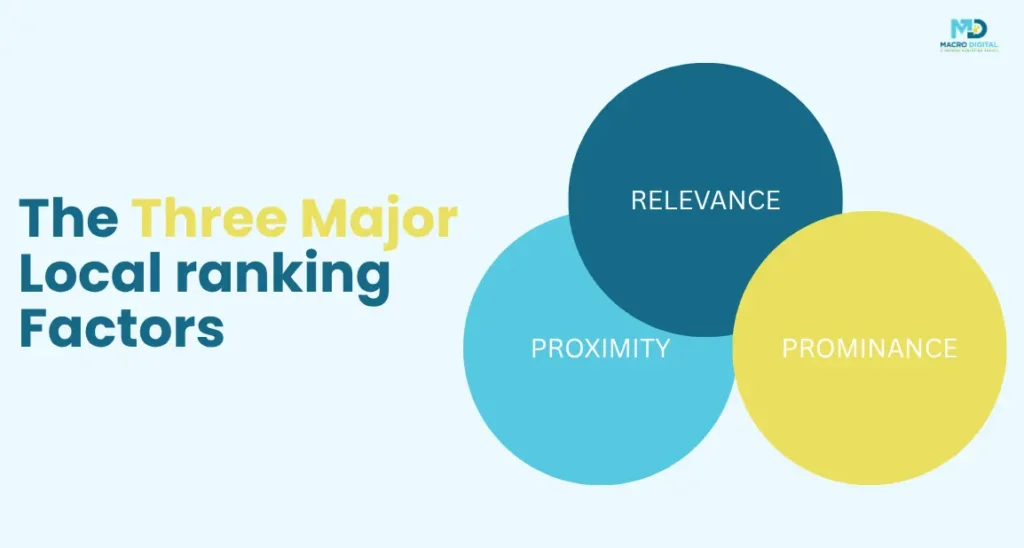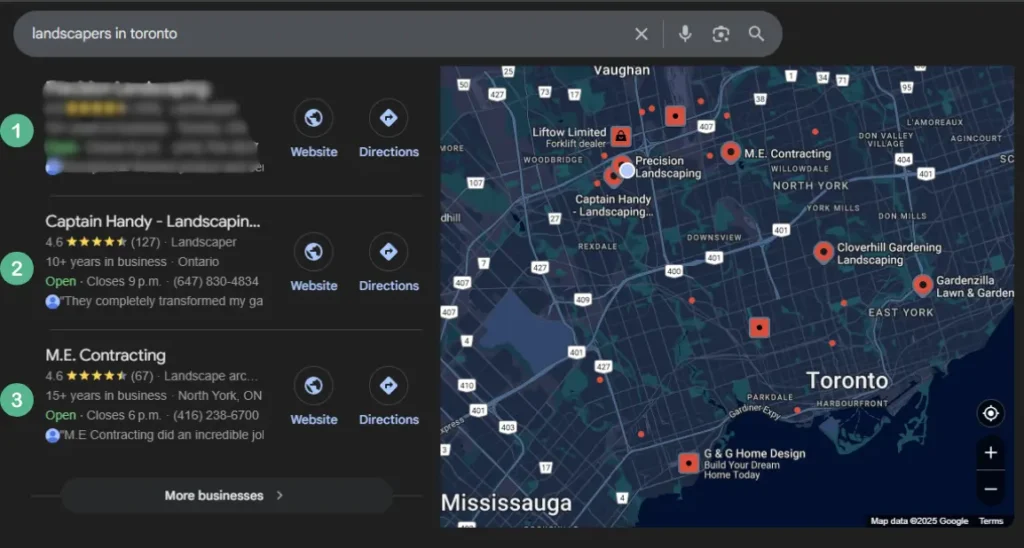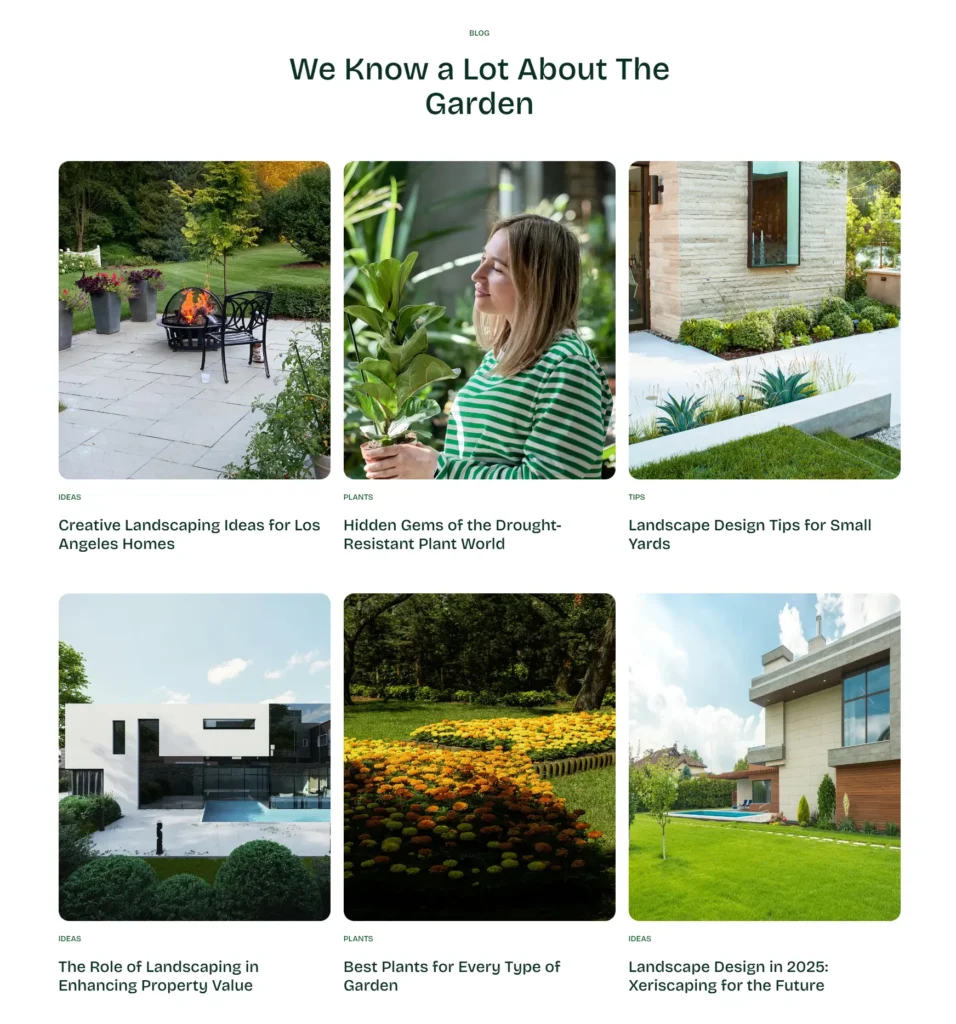When homeowners need lawn care, garden design, or patio installation, 97% of them search online to find a local business.
If your landscaping company doesn’t appear on the first page of Google, chances are those potential clients are calling your competitors instead.
In fact, the top 3 Google results capture over 68% of all clicks, while businesses buried on page two get less than 1% (Backlinko).
For landscapers, that difference can mean hundreds of missed calls and quote requests every month.
That’s where SEO (Search Engine Optimization) comes in.
A well-optimized website and Google Business Profile can help your landscaping business show up in local searches, attract more homeowners, and build trust before they ever pick up the phone.
In this guide, we’ll break down proven SEO strategies specifically for landscapers from keyword research and Google Business optimization to local citations, content marketing, and link building.
Whether you’re a solo landscaper or run a multi-location company, these tactics will help you rank higher, get more leads, and grow your landscaping business online.
Free Discovery Call
Ready to Grow Your Business?
Let’s turn your vision into reality. Book a free consultation and discover how Macro Digital can help you scale.
Why SEO Matters for Landscaping Businesses
In today’s digital world, word-of-mouth alone isn’t enough to keep your landscaping business growing.
Homeowners rely on Google to find and compare local landscapers, check reviews, and request quotes.
Investing in SEO ensures your business shows up right where they’re looking, giving you a steady stream of qualified leads without relying solely on ads or referrals.
Just like other local service providers from plumbers to HVAC technicians, landscapers benefit most from location-based strategies that help them appear in local searches.
In fact, many of the same principles used in SEO for HVAC companies also apply to landscaping businesses, such as optimizing Google Business Profiles, targeting city-specific keywords, and collecting customer reviews.
How Homeowners Search for Landscaping Services
Most homeowners start with a local search like “landscaping company near me” or “lawn care in [city].”
According to Google, 46% of all searches have local intent, and mobile searches for “near me” services have grown by over 200% in the past few years.
That means if your landscaping company isn’t optimized for local search, you’re invisible to nearly half of your potential customers.
The Google Maps Advantage
Appearing in the Local Map Pack those top 3 business listings that show under the map can drastically increase your visibility.
Studies show businesses in the map pack receive up to 44% of all local clicks, making it one of the most valuable spots to appear for landscapers.
Why Paid Ads Alone Aren’t Enough
Google Ads and social media campaigns can drive short-term results, but they stop the moment you stop paying.
SEO, on the other hand, builds long-term equity for your website.
Once you start ranking organically, you continue to attract leads 24/7 without additional ad spend.
In fact, 70% of online users prefer organic listings over paid ones, viewing them as more trustworthy.
Real Example: How SEO Doubled Leads for a Local Landscaper
A landscaping company in Ontario optimized its Google Business Profile, added service-specific pages, and started publishing seasonal blog posts like “Spring Lawn Care Tips.”
Within six months, they saw a 92% increase in organic traffic and nearly doubled their quote requests, all without spending more on advertising.
How Google Ranks Landscaping Companies
Understanding how Google decides which landscaping companies appear at the top of search results is key to building a strong online presence.
The search engine doesn’t just pick businesses randomly, it evaluates hundreds of signals to determine which ones are most relevant, trustworthy, and geographically close to the searcher.
The Three Local Ranking Factors

Google uses three main pillars to rank local service providers like landscapers.
Knowing how these work helps you optimize your online presence for better visibility.
Relevance: Matching Search Intent
Relevance measures how closely your business matches what someone is searching for.
To improve this, make sure your website content and Google Business Profile clearly describe your services, such as “landscape design,” “tree trimming,” or “lawn care.”
The clearer your service details, the easier it is for Google to connect you with the right audience.
Distance: Proximity to the Searcher
Google aims to show searchers nearby businesses, so your address, service areas, and business listings should all be consistent.
The closer you are to a user’s location, the more likely you are to appear in the Local Map Pack the top three listings that show under the map in search results.
Prominence: Online Authority and Reputation
Prominence reflects how well-known and trusted your business is online.
This includes customer reviews, backlinks, local citations, and social mentions.
A landscaper with dozens of 5-star reviews and consistent listings across platforms like Yelp, Facebook, and HomeStars is far more likely to rank above competitors with weaker online reputations.
Common SEO Mistakes Landscapers Make
Even skilled landscapers can struggle to rank well if they overlook key SEO fundamentals.
Here are the most common mistakes that hold businesses back and how to avoid them.
Using Thin or Generic Service Pages
Google favors depth and detail. Instead of lumping all your services together on one page, create separate, keyword-optimized pages for each offering for example, “Garden Design,” “Irrigation Installation,” and “Lawn Aeration.”
Ignoring NAP Consistency
Your Name, Address, and Phone number (NAP) must be identical across every platform from your website footer to business directories.
Inconsistencies confuse Google and can cause ranking drops.
Neglecting Google Business Profile Updates
An outdated or incomplete profile signals inactivity.
Regularly updating your Google Business Profile with new photos, service updates, and posts shows both Google and potential clients that your business is active and engaged.
Keyword Research for Landscapers

Keyword research is the foundation of every successful landscaping SEO strategy.
It helps you understand exactly what homeowners are typing into Google when they’re looking for services like lawn care, backyard design, or tree removal.
By targeting the right mix of service-based and location-based keywords, you can attract qualified local leads and increase your chances of ranking in your service area.
Start with Service and Location Keywords
When it comes to landscaping SEO, you want to appear for the searches that show buying intent when people are actively looking to hire.
The best way to do that is by combining your core services with your target locations.
Combine What You Do + Where You Do It
Google prioritizes search results that clearly match both the service and the searcher’s location. For example:
- “Landscaping company in Toronto”
- “Lawn care services Mississauga”
- “Tree trimming in Vaughan”
These types of searches often lead directly to phone calls and quote requests.
Include Service Variations and Synonyms
Homeowners don’t always use the same words you do. To capture more search traffic, include related terms like:
- “Yard cleanup”
- “Landscape design”
- “Garden maintenance”
- “Sod installation”
Mixing variations naturally into your content ensures Google recognizes your relevance across a wider range of searches.
Find Long-Tail Keyword Opportunities
Long-tail keywords are longer, more specific phrases that show clear search intent often from people who are closer to making a decision.
Though they have lower search volume, they tend to convert at much higher rates.
For example, landscapers can attract quality leads through targeted searches like “affordable backyard landscaping ideas” or “best lawn care company in Calgary.”
Similar strategies are used in other industries, such as SEO for electricians, where optimizing for niche, service-specific queries like “licensed electrician near me” helps capture high-intent local customers.
Though they have lower search volume, they tend to convert at much higher rates.
What Long-Tail Keywords Look Like
Examples of high-converting long-tail searches for landscapers include:
- “Affordable backyard landscaping ideas”
- “Best lawn maintenance company in Calgary”
- “Eco-friendly landscaping services near me”
- “When to aerate your lawn in spring”
Targeting these terms in blog posts and service pages helps you attract clients at different stages of the decision-making process.
How to Find Long-Tail Keywords
You can discover them by using Google’s Autocomplete suggestions, People Also Ask results, or related searches at the bottom of search pages.
Tools like AnswerThePublic or Ubersuggest also reveal questions people are asking in your niche.
Best Tools for Keyword Research
Doing keyword research manually can be time-consuming.
Fortunately, several tools make it easier to identify high-value keywords, analyze competitors, and monitor your performance.
Google Keyword Planner
Google’s free tool gives you search volume data, keyword ideas, and geographic insights perfect for landscapers targeting local areas.
SEMrush and Ahrefs
These professional tools help you find what keywords your competitors rank for and spot gaps in your own strategy.
They’re ideal for tracking progress and planning long-term SEO campaigns.
Ubersuggest and Google Search Console
Ubersuggest offers beginner-friendly keyword data, while Google Search Console shows you which search queries already bring visitors to your site helping you identify easy wins.
On-Page SEO for Landscaping Websites
Your website is the digital storefront of your landscaping business and it’s often the first impression potential clients get of your brand.
On-page SEO ensures that your site is both search engine-friendly and user-friendly, helping Google understand your content while guiding visitors to take action.
When properly optimized, your website can become a steady lead generator for your landscaping services.
Optimize Your Core Pages
Your main website pages including the homepage, service pages, and contact page carry the most SEO weight.
Optimizing them correctly helps both search engines and visitors instantly understand what you do and where you operate.
Homepage Optimization
Your homepage should clearly communicate your core services, target area, and brand identity. Include your primary keyword in the title tag and H1, such as “Professional Landscaping Company in Toronto.”
Use strong calls-to-action like “Get a Free Quote” or “Book a Consultation” to drive conversions.
Create Dedicated Service Pages

Instead of combining all services on a single page, build individual service pages targeting specific keywords for example:
- Lawn Maintenance
- Tree Trimming
- Garden Design
- Snow Removal
This makes it easier for Google to rank your pages for multiple services and gives each one a chance to show up for relevant searches.
Include a Local Contact or About Page
Adding a detailed Contact or About Us page with your full Name, Address, and Phone number (NAP), along with an embedded Google Map, improves local SEO and makes it easier for clients to find you.
On-Page SEO Best Practices
Strong on-page SEO isn’t just about keywords it’s about structure, clarity, and engagement.
Following best practices ensures that your pages not only rank well but also convert visitors into customers.
Optimize Title Tags and Meta Descriptions
Your title tags and meta descriptions are what searchers see first on Google.
Keep them descriptive, include your city or region, and write them in a way that encourages clicks.
Example: “Toronto Landscaping Services | Expert Lawn & Garden Care by GreenScape”
Use Headings and Keyword Placement Wisely
Organize your content using H1, H2, and H3 tags.
Naturally include your target keywords in headings, introductions, and image descriptions but avoid overusing them.
Readability should always come first.
Add Before-and-After Photos with Alt Text
Visual proof of your work can dramatically increase engagement.
Use high-quality before-and-after photos and include descriptive alt text like “backyard patio installation in Mississauga” to help with SEO and accessibility.
Internal Linking and Schema Markup
Beyond visible content, there are technical on-page elements that play a crucial role in SEO.
Internal linking and schema markup help search engines understand how your site is structured and who your business serves.
Build Internal Links Between Pages
Link related pages together to create a smooth user journey and pass link equity across your website.
For example, link your “Lawn Maintenance” page to your “Seasonal Cleanup” or “Fertilization Services” pages.
Use LocalBusiness Schema Markup
Adding LocalBusiness schema to your site’s code helps Google identify your company’s key information like business name, address, service area, and reviews.
This can lead to rich snippets in search results and better local visibility.
Google Business Profile Optimization

Your Google Business Profile (GBP) is one of the most powerful tools for attracting landscaping clients in your local area.
It’s often the first thing potential customers see when they search for a “landscaping company near me.”
Optimizing your GBP helps you appear in Google Maps and the Local Pack, boosts trust with reviews and photos, and drives calls directly from search results without users ever visiting your website.
Claim and Verify Your Google Business Profile
Before optimizing your profile, you first need to claim and verify it.
This tells Google that your business is legitimate and ensures you have full control over the information displayed to customers.
How to Claim and Verify
Go to Google Business Profile Manager, sign in with your Google account, and search for your business.
If it’s not listed, you can create a new profile.
Google may ask you to verify via video, phone, or email. Once verified, you can edit and manage your business details directly.
Optimize Every Section of Your Profile
After verification, every part of your profile should be optimized with accurate, keyword-rich information.
Google rewards complete and detailed listings with better visibility.
Choose the Right Business Categories
Your primary category should directly reflect your main service, such as “Landscaper” or “Landscape Designer.”
You can also add secondary categories like “Lawn Care Service,” “Tree Service,” or “Gardener” to expand your reach.
Write a Compelling Business Description
Your description should summarize your services, location, and value proposition in around 750 characters. Include your target keywords naturally for example:
“GreenScape Landscaping provides professional lawn care, garden design, and patio installation services across Mississauga and the Greater Toronto Area.”
Add Your Services, Hours, and Service Areas
Complete every detail including your working hours, contact number, website, and service areas.
Accurate data builds trust and ensures Google matches you to the right local searches.
Use Posts, Photos, and Q&A Features
A well-maintained profile shows Google that your business is active, trustworthy, and relevant.
Posting regularly and engaging with customers helps improve your ranking over time.
Publish Weekly Google Posts
Use GBP Posts to share updates, promotions, or project highlights.
Posts with original photos tend to perform better and can help you stay visible in local searches.
Upload High-Quality Photos and Videos
Businesses with photos get 42% more requests for directions and 35% more website clicks (Google).
Share before-and-after landscaping shots, team photos, and equipment in action to make your listing stand out.
Respond to Questions in the Q&A Section
Monitor your Q&A tab regularly. Responding promptly to customer questions builds trust and demonstrates good customer service, which contributes to stronger visibility.
Collect and Manage Customer Reviews
Customer reviews are one of the most powerful ranking and conversion signals for local SEO.
They help Google gauge your credibility and help potential clients make quick decisions.
Ask for Reviews After Each Job
Encourage satisfied clients to leave a Google review.
You can share a direct review link via text or email to make it simple.
The easier you make it, the more reviews you’ll receive.
Respond to Every Review Good or Bad
Replying to reviews shows that you value customer feedback.
Thank clients for positive comments and handle negative ones professionally to maintain your reputation.
Keep Reviews Consistent Over Time
Google prefers steady review activity rather than sudden spikes.
Aim to collect reviews consistently throughout the year to show ongoing customer engagement.
Local SEO: Strengthen Your Area Authority
Local SEO helps your landscaping business dominate search results within your city or service area.
It focuses on improving your visibility in local map listings, directories, and community searches making sure you’re the first name homeowners see when looking for services nearby.
By building strong local signals, you increase both your online authority and your chances of earning more calls and quote requests from nearby clients.
Local SEO isn’t just vital for single-location businesses, it’s also a game-changer for multi-location brands and franchise networks.
The same principles used in local SEO for franchise businesses apply to landscapers too, such as maintaining NAP consistency, optimizing individual location pages, and collecting local reviews.
Whether you manage one office or several crews across different cities, local optimization ensures each location gets discovered by nearby homeowners.
Ensure NAP Consistency Across All Platforms
Consistency is key in local SEO. Google uses your Name, Address, and Phone number (NAP) to verify that your business information is accurate and trustworthy. Even small inconsistencies can hurt your rankings.
Maintain Identical Information Everywhere
Your NAP should appear exactly the same across your website, Google Business Profile, Yelp, Facebook, and all directories.
For example, if your address is “123 Main St.,” don’t list it as “123 Main Street” elsewhere. These small details matter to Google’s algorithm.
Keep Your Website Footer Updated
Include your full NAP information in your website footer or contact page. This helps both users and search engines confirm your business details and location.
Build Local Citations and Backlinks
Citations and backlinks from local websites help establish credibility and reinforce your geographic relevance.
The more often your business appears on reputable local platforms, the stronger your authority becomes.
Submit Your Business to Local Directories
Start with trusted platforms like HomeStars, Houzz, Yelp, YellowPages, and the Chamber of Commerce.
These sites not only drive referral traffic but also boost your local SEO signals.
Collaborate with Local Businesses and Sponsors
Partner with nearby nurseries, real estate agents, or home improvement stores.
Exchanging mentions or co-sponsoring events creates organic backlinks and exposure to a relevant audience.
Participate in Community Events
Sponsoring or participating in local events (like garden fairs or neighborhood cleanups) can lead to PR mentions and backlinks from community websites, valuable signals for Google’s local ranking algorithm.
Create City or Neighborhood Landing Pages
If your landscaping business serves multiple areas, city-specific landing pages can help you rank for searches in each location.
These pages make it clear to Google — and customers — that you serve specific neighborhoods.
Include Location-Specific Content
Each city page should feature unique content like testimonials from local clients, nearby landmarks, and area-specific keywords.
Avoid copying the same text for every city; tailor each one for authenticity.
Add Maps, Reviews, and Local Photos
Embed a Google Map showing your business service area and include local project photos.
This not only strengthens your SEO but also builds trust with nearby homeowners who can see your work in their area.
Link City Pages to Core Service Pages
Cross-linking your city landing pages with your main service pages helps Google understand the relationship between your services and your service areas, improving both rankings and user navigation.
Content Marketing Ideas for Landscapers
Content marketing allows landscapers to showcase their expertise, attract more organic traffic, and build trust with homeowners before they even make contact.
By publishing useful, engaging, and locally relevant content, you position your landscaping business as the go-to expert in your area helping potential customers choose you over competitors.
Blog Topics That Build Trust and Traffic

The right blog topics can attract homeowners searching for solutions, seasonal advice, or inspiration.
Writing valuable content around these topics helps you show up for long-tail keywords and build authority over time.
Write About Seasonal Landscaping Tips
Seasonal content performs well because homeowners often search for help at specific times of the year. Examples include:
- “Spring Lawn Cleanup Checklist”
- “How to Protect Your Garden Before Winter”
- “Best Fall Landscaping Ideas for Curb Appeal”
Share How-To and Educational Guides
Informative guides like “How to Choose the Right Plants for Your Backyard” or “How Often Should You Mow Your Lawn?” help establish your business as an expert resource.
Publish Before-and-After Project Features
Showcase transformation projects with photos, process details, and client stories.
These articles not only build trust but also encourage local homeowners to envision what you can do for their property.
Showcase Your Expertise Through Visual Content
Visual content performs exceptionally well for landscaping companies.
Homeowners want to see the results of your work and images or videos help you stand out in both Google and social feeds.
Create Before-and-After Galleries
Add photo galleries to your website or Google Business Profile showing transformations of lawns, patios, or gardens.
Visual proof builds confidence and engagement.
Post Short Videos on Social Media
Quick, engaging videos of your projects whether it’s a time-lapse of a yard cleanup or a walkthrough of a finished garden attract attention and generate leads through platforms like Instagram and YouTube.
Turn Blog Posts into Visuals or Infographics
Repurpose your written content into infographics, tips, carousels, or short “Did You Know?” posts to increase shareability and reach.
Leverage Local and Community-Focused Content
Local content helps your landscaping business stand out in your area and connect with nearby homeowners searching for trusted professionals.
Write About Local Projects or Events
Highlight recent landscaping projects completed in your area or cover community events you’ve participated in. This signals local relevance to Google and builds credibility.
Partner with Local Influencers or Businesses
Collaborate with local home improvement bloggers, real estate agents, or garden centers for cross-promotions or interviews.
These partnerships can generate backlinks and local visibility.
Share Testimonials and Case Studies
Publishing client stories and testimonials with location details adds authenticity and reinforces your presence in the community.
Link Building for Landscaping Companies
Link building is one of the most effective ways to improve your website’s authority and search rankings.
For landscapers, earning backlinks from reputable and locally relevant websites helps Google view your business as trustworthy and credible.
The more high-quality links pointing to your site, the higher you’ll rank and the more local homeowners will find your services.
Earn Links Through Local Partnerships
Building partnerships within your community is one of the easiest and most natural ways to earn local backlinks.
These relationships also open the door to long-term referrals and collaborations.
Collaborate with Local Businesses
Partner with garden centers, real estate agents, or home renovation companies to exchange website mentions or co-create local content.
For example, write a joint blog post like “How Landscaping and Real Estate Work Together to Increase Property Value.”
Sponsor Local Events or Charities
Sponsoring community events such as neighborhood cleanups, home expos, or gardening fairs often earns you a link from the event’s website.
It also boosts your reputation and visibility among locals.
Join Professional Associations
Membership in landscaping or home improvement associations (like the Landscape Ontario or Canadian Nursery Landscape Association) often includes a profile page linking back to your website with a strong, authoritative backlink.
Submit Work to Industry Blogs and Directories
Submitting your work to reputable websites in the landscaping and home improvement space helps you reach wider audiences while earning SEO value from trusted platforms.
Get Listed on Trusted Directories
Add your business to well-known directories like HomeStars, Houzz, Yelp, and Angie’s List. These sites often rank highly in Google and can drive valuable referral traffic.
Feature Your Projects in Industry Blogs
Share your best projects with landscaping or home design blogs that feature before-and-after makeovers. Many of these sites link back to your website in the feature.
Create a Portfolio on Visual Platforms
Showcasing your work on Pinterest or Houzz not only helps generate leads but also builds backlinks through visual content sharing.
Use Guest Posting and PR Outreach
Guest posting and PR are excellent ways to earn backlinks while positioning yourself as an expert in landscaping and outdoor design.
Contribute to Local or Niche Blogs
Write articles for local lifestyle, home improvement, or community blogs on topics like “Top Landscaping Trends for 2025.”
These backlinks carry strong authority and relevance.
Send Press Releases for Notable Projects
If your landscaping company wins an award, launches a new service, or completes a major community project, send out a press release to local media outlets.
These stories often generate backlinks and brand awareness.
Build Relationships with Journalists and Writers
Sign up for services like Help a Reporter Out (HARO) or Qwoted to connect with journalists looking for expert insights.
When quoted, you’ll often receive a backlink to your website.
Tracking Your SEO Results
SEO isn’t a one-time effort, it’s an ongoing process that needs consistent tracking and adjustment.
By monitoring your results, you’ll see which strategies are working, which keywords drive leads, and where you need to improve.
Tracking ensures that every hour and dollar you invest in SEO brings measurable returns for your landscaping business.
Measure Key SEO Metrics
Understanding your performance metrics helps you identify growth opportunities and refine your strategy.
The right tools can show you where your website stands today and how to scale its visibility.
Monitor Website Traffic with Google Analytics
Use Google Analytics or Google Search Console to see how much organic traffic your website is getting, where visitors come from, and which pages convert best.
Look for steady growth in traffic from search engines like Google and Bing.
Track Keyword Rankings Over Time
Tools like SEMrush, Ahrefs, or BrightLocal let you monitor how your target keywords rank in search results.
Pay special attention to local keywords like “landscaping company in [city]” or “lawn care near me.”
Review Google Business Profile Insights
Your Google Business Profile dashboard shows valuable engagement data such as how many people called you, requested directions, or visited your website directly from search results.
Analyze Lead Sources and Conversions
Tracking where your leads come from helps you measure the real ROI of your SEO campaigns.
Use Call Tracking Numbers
Call tracking software (like CallRail or WhatConverts) can help identify which pages or keywords generate phone inquiries.
This lets you double down on what’s working.
Set Up Conversion Goals in Google Analytics
Define goals such as form submissions, quote requests, or calls.
Tracking conversions gives you a clear picture of how effectively your website turns visitors into clients.
Use UTM Parameters for Campaign Tracking
If you’re running local ads or sharing links on social media, add UTM parameters so you can see exactly which campaigns drive the most organic conversions.
Adjust and Improve Based on Performance
SEO is all about refinement. Regularly analyzing your data ensures you stay ahead of competitors and maintain strong rankings.
Identify Top-Performing Pages
Find which pages drive the most traffic and leads.
Update them periodically with new images, reviews, or content to maintain ranking strength.
Improve Underperforming Content
For pages that don’t attract clicks or conversions, revisit your keywords, title tags, or copy.
Sometimes a small update like adding location-based terms or better CTAs can make a big difference.
Track Competitors’ Progress
Use competitor analysis tools to see what nearby landscaping companies are ranking for.
Look for keyword or backlink opportunities they’re using that you can replicate or improve upon.
Conclusion
SEO for landscapers isn’t just about ranking higher it’s about building visibility, trust, and long-term business growth.
With the right strategy, your landscaping company can consistently attract qualified leads, outshine competitors, and turn online searches into paying clients.
By staying consistent with optimization and content, you’ll position your business as the top choice in your area.
Key Takeaways
Every landscaper can benefit from a solid SEO plan.
Here’s a quick recap of the most important lessons from this guide:
Focus on Local Visibility
Optimize your website and Google Business Profile to dominate searches in your service area and appear in the local map pack.
Publish High-Quality Content Regularly
Create blogs, guides, and visual content that answer customer questions and showcase your landscaping expertise.
Build Authority Through Links and Reviews
Earn backlinks from trusted local sources and collect steady customer reviews to strengthen your online credibility.
Track and Improve Performance
Use tools like Google Analytics, Search Console, and BrightLocal to monitor rankings, traffic, and leads and continuously refine your SEO strategy.




